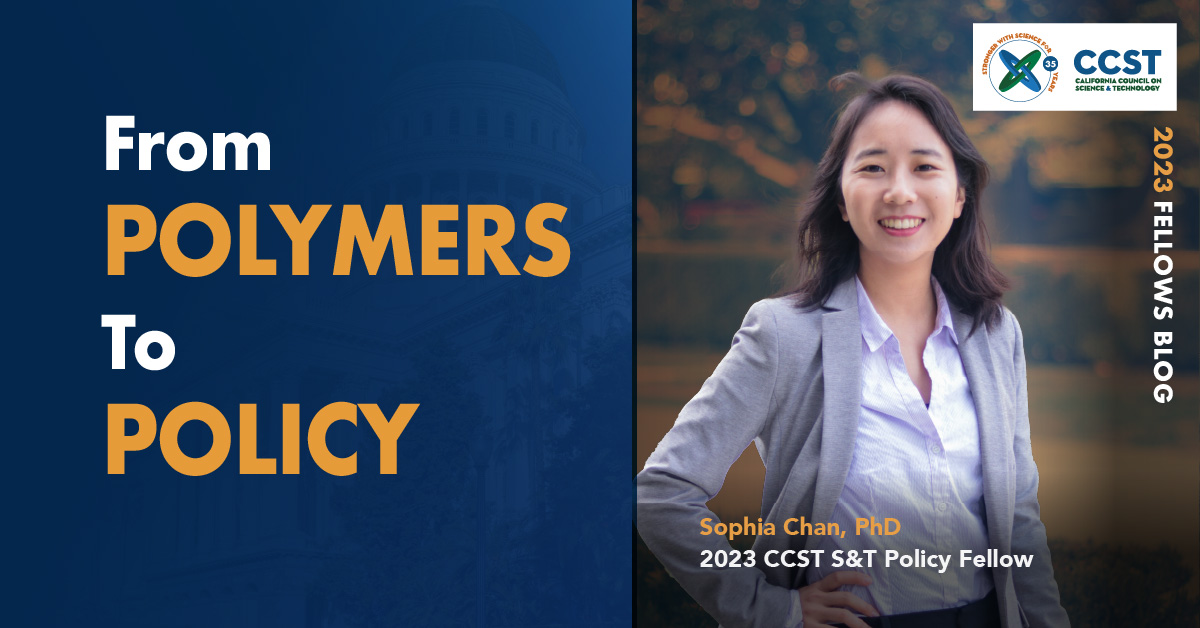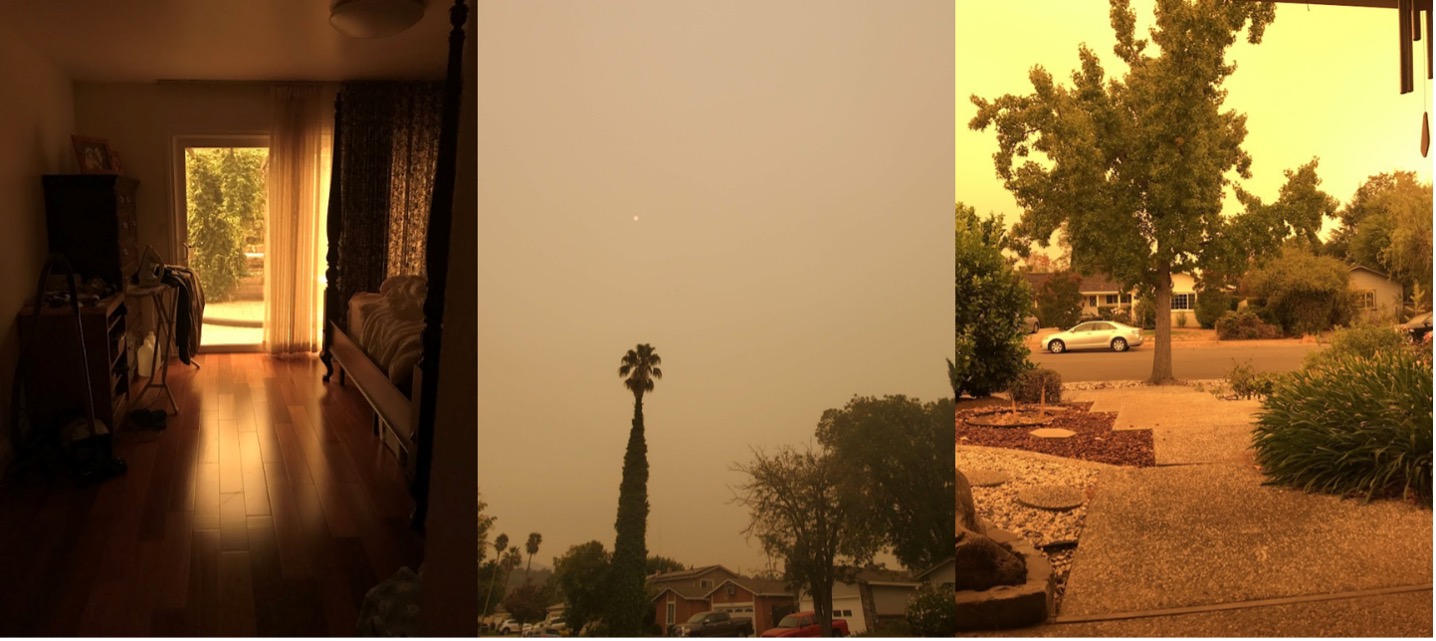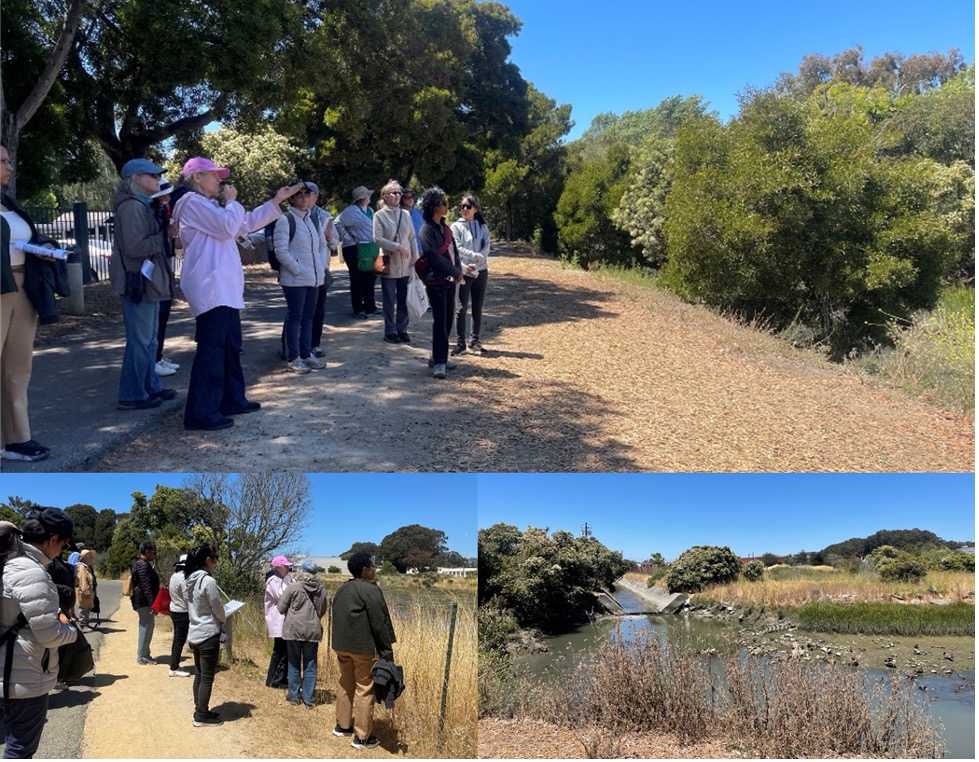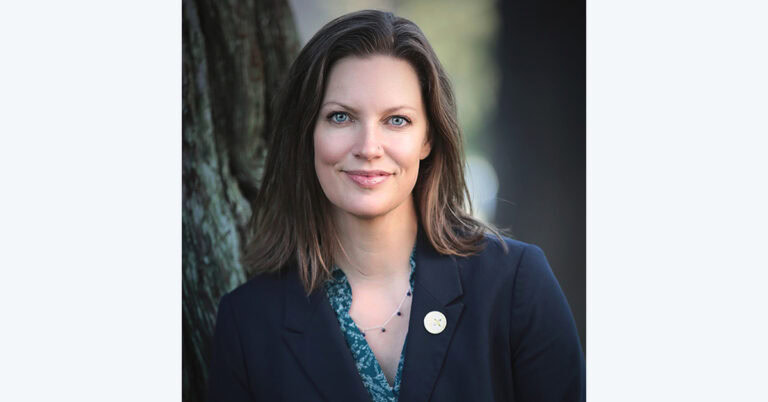Deputy Director
Q&A: From Polymers to Policy with 2023 Fellow Sophia Chan, PhD
August 7, 2023 | CCST Newsroom, CCST S&T Policy Fellows | Contact: Mikel Shybut

What did you study in grad school and why did you decide to go into policy?
I earned my PhD in Chemical Engineering at Columbia University, where I studied nanotechnology and polymers to make carbon capture more efficient.

But I remember the moment when I realized I needed to go into environmental and climate policy. I was in NYC during lockdown, trying to figure out the Kuhn length of a specific polymer at a specific annealing temperature, when I got a text from my sister:
“We’re packing.”
I was confused.
“We got an evacuation warning.”
It was August 2020 during the California lightning wildfires, and the fires had reached my family home in the Bay Area. Family and friends sent me photos of their homes with soot in the windows and a backdrop of orange sky.

“What am I doing? Climate change is happening now, and I need to make a more immediate impact.”
The fall semester after the wildfires ravaged my hometown, I began taking environmental policy and climate change law classes. I attended a multi-week policy colloquium, cold-messaged policy fellows on LinkedIn, and talked about going into environmental policy with everyone I knew. I already spent nine years in energy research, so I was doing all I could to make up for lost time.
One day, an old labmate texted me to check in, and I told him what I wanted to do after PhD.
“You should check out CCST. An old friend from high school works there now.”
—
Where are you placed and what kind of work are you doing? How has training informed your experience so far?
I am serving as a legislative analyst at CalEPA’s Department of Toxic Substances Control’s (DTSC) Office of Legislation and Regulatory Review (OLRR). I communicate information between the scientists and engineers at DTSC who have deep scientific knowledge about hazardous substances, and the author’s offices and advocacy groups who are trying to pass their bills.
CCST’s training focused a lot on how a bill becomes law, or moves from ideation to the Governor’s desk. With that information in mind, I hit the ground running in my legislative office where we track bills on solar panel recycling, electric vehicle battery manufacturer responsibility programs, and perfluoroalkyl and polyfluoroalkyl substances (PFASs, “forever chemicals” like DDT) bans in consumer products. Training familiarized me with the structure and calendar of the legislature so I can make informed decisions with the help of my team.
I also lead legislative “roll-out” projects, which are strategic plans of contacting legislative offices about high-profile or highly sensitive issues that DTSC regulates or is involved in. These plans are intended to target legislative offices that are likely to be most interested in the information and may want to engage with DTSC going forward. I was tasked with legislative roll-out of DTSC’s Hazardous Waste Management (HWM) Report. Should we should contact offices with a lot of hazardous waste generators or prioritize offices with high CalEnviroScreen scores? Should we call them or send an email? Should it be tailored or generic? Based on the specific issue, should the Director contact the Member, or would it be more effective to leverage staff-to-staff relationships? These were the questions I asked myself and my mentors to generate a tiered strategy for legislature engagement of the HWM Report.

—
What are your career goals and how is the Fellowship impacting them?
My career goals are to help make significant reductions in global carbon emissions. Through my CCST alumni mentor, I learned that large movements in energy and climate policy happen through advocacy work, which are NGOs or private sectors swaying the legislature and the executive branch to create certain policies and regulations. I am particularly passionate about public transportation, energy technology deployment, environmental justice, and waste management.
The CCST Fellowship has allowed me to work with a state agency and the legislature to see how both operate. Very few people really understand how a bill becomes law or how to implement it, and, more importantly, how to influence that process. This knowledge as well as the written and oral communication skills I’ve honed during this Fellowship prepare me well for the world of climate and energy advocacy.
—
What is it like to live in Sacramento?
Moving from NYC to Sacramento was definitely a huge change. I refuse to own a car, so I put in a lot of effort in securing a room downtown. I still have to walk 15 min to Target to pick up groceries, but I feel better about not emitting carbon emissions and also saving thousands of dollars on the car itself as well as hundreds per month on insurance, gas, maintenance, etc.
My Sacramento townhouse is definitely the cleanest, biggest, and cheapest place I’ve ever lived in, given that I used to live in dingy apartments in NYC or Berkeley. I still feel guilty depending on people to give me rides to go to a hangout further out, whereas in NYC trains run 24/7, so a hangout is $2.75 away.
—
Do you work in the office or remotely?
My office has kept the remote work of the pandemic: there is only one in-person staff meeting a week, which I love. I don’t have to commute every day; I can do chores during breaks and focus without the sound of meetings in the cubicle next to me. My team also sets up weekly one-on-one check-ins, daily team check-ins at the start of the day, and occasional team outings and lunches during the in-person office days.

—
What is the role of mentorship during the Fellowship?
Mentorship fit was my number one priority for CCST, and I highly recommend anyone in a fellowship program to prioritize mentorship as well. I wanted a mentor who is kind, empathetic, and approachable; I wanted a mentor that I could ask any question without fear, who would provide positive and constructive feedback as well as validation and guidance. It’s only a one-year Fellowship, and I came in as a polymer physicist not knowing any of the history, context, or people. It has been extremely valuable for me to have mentors who know these things, can gently show me the ropes, and then let me set sail on multiple bill analyses for the Governor’s desk.
One example of mentorship in my office is while I found my legislative work valuable, I missed using code and excel to analyze data. I felt comfortable expressing this feeling to my mentor, and she actively searched for and found me some meaningful projects within DTSC that extensively utilized code and excel. She also touched base with other mentors to make sure that I would have the space and time to work on the project outside of my usual legislative duties.
—
What are you up to after the Fellowship?
I am excited to be the incoming 2023-2024 American Physical Society Congressional Fellow, where I’ll be working for a Senator or a Representative in a personal office or a committee office. I have been tapping into CCST and DTSC networks to meet people who are currently living in DC and/or working on national energy and environmental policy. I hope to work on energy and environmental portfolios and bring what I’ve learned from CCST and DTSC to the national scale.
—
Note: The views reflected in this blog piece are Dr. Chan’s individual views and do not reflect those of the Department of Toxic Substances Control.
About the CCST Science & Technology Policy Fellowship
The CCST Science & Technology Policy Fellows program places PhD-level scientists, engineers, and social scientists in the California State Legislature, State Agencies, and Offices of the Governor for a year of public policy, leadership training, and public service—training scientific thinkers to be policy-savvy, while helping equip California’s decision makers with science-savvy staff. Discover how our CCST S&T Policy Fellows make a difference in California’s policy arena and learn how to apply at CCST.us/CCST-Science-Fellows-Program.




